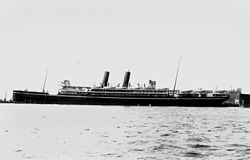Morea (ship)
|
||||||||||||||||||||||||||
|
||||||||||||||||||||||||||
|
||||||||||||||||||||||||||
|
||||||||||||||||||||||||||
|
||||||||||||||||||||||||||
The Morea was a passenger ship of the British shipping company Peninsular and Oriental Steam Navigation Company (P&O) put into service in 1908 , which was used in passenger and mail traffic from Great Britain to India and Australia . The Morea served in the First World War both as a troop transport and as a hospital ship . Back in 1919, it was decommissioned in 1930 and scrapped in Japan .
The ship
The 10,890 GRT steamship Morea was the sixth of P & O's M-Class passenger and mail ships. Between 1903 and 1911 a total of ten more or less identical ships of this class were put into service. The sister ships of the Morea were the Moldavia (1903), the Mongolia (1903), the Mamora (1903), the Macedonia (1904), the Mooltan (1905), the Malwa (1909), the Mantua (1909), the Maloja ( 1912) and the Medina (1912). Of these ten ships, six were sunk by German torpedoes or sea mines during the First World War . The last one to be scrapped was the Mantua in Shanghai in 1935 .
The ship was 164.53 meters long and 18.65 meters wide and had two funnels, two masts and two propellers . It was powered by the shipyard's quadruple expansion steam engines, which developed 13,000 PSi and allowed a top speed of 16 knots. Four single-ended and four double-ended Scotch steam boilers were installed in the boiler rooms . The passenger accommodations were designed for 407 passengers in the first and 200 passengers in the second class.
history
The Morea was laid on November 5, 1907 at Barclay, Curle and Company in the Glasgow district of Whiteinch and was launched on August 15, 1908. The ship was the wife of William Russell Ferguson, the manager of the shipyard , the name Morea baptized. The name refers to an ancient name for the Greek peninsula Peloponnese . On November 3, 1908, the Morea completed its test drives and the following day it was approved by P&O. It had cost a total of £ 309,692 in terms of monetary value at the time . On December 4, 1908, put Morea in London on her maiden trip to Marseille , Sue , Colombo , Melbourne and Sydney from.
In 1909 the steamer was equipped with a Marconi set for wireless radio . In November 1911 she offered the steamer Perim of the Ellerman Lines , which was in distress between Plymouth and Ouessant , to take him in tow. The steamer San Remo then took over . In 1911 and 1912 the Morea made two unscheduled crossings to Auckland (New Zealand). On July 26, 1914, the news of the outbreak of the First World War reached the ship by wireless radio, which was just off the Cocos Islands in the Indian Ocean .
On September 7, 1914, during another crossing from London to Sydney, the Indian crew members refused to continue their service after leaving Bombay . Because the German light cruiser Emden was operating in the area, the Morea had been diverted to Bombay. A group of Royal Engineers, British pioneers who came aboard in Colombo, had to help moor with the mooring and casting off maneuvers, and the decks were scrubbed by passengers for the remainder of the voyage. At the end of 1915, the Morea was harnessed as an ambulance ship and troop transport for the Australian Expeditionary Force. In March 1916, she was returned to P&O and resumed regular passenger and mail services.
On May 19, 1917, however, she was then requested as an armed auxiliary cruiser (Armed Merchant Cruiser) and equipped with seven 6-inch cannons. On July 5, 1917, she was put into service as an auxiliary cruiser and from then on served as an escort ship between the Naval Base Devonport and West Africa .
On May 14, 1918, the Morea entered Rio de Janeiro . This was the only time in her entire career that she called at a South American port. At the end of June 1918, she was walking through the area in which the hospital ship HMHS Llandovery Castle had been sunk shortly before , and came across an extensive carpet of rubble and corpses of soldiers, crew members and nurses.
After the end of the war, she was returned to her shipping company on October 18, 1919 and overtaken on the Clyde . Since the repair was delayed, the ship was nicknamed HMS Neversail . On October 17, 1919, the Morea was able to leave for her first civilian voyage after the end of the war. On June 17, 1930, the ship was sold to Summers & Co. in Kobe, Japan, for demolition and was broken up there in October 1930.

